The Role of Hydroponics in Modern Marijuana Farming

Understanding Hydroponics in Marijuana Farming
Hydroponics is a method of growing plants without soil, using nutrient-rich water instead. This innovative technique has gained popularity in marijuana farming due to its efficiency and effectiveness. By eliminating soil, growers can better control the environment and nutrient delivery, leading to healthier plants and higher yields.
Hydroponics allows you to grow plants in a controlled environment, providing optimal conditions for growth without the limitations of soil.
In hydroponic systems, the roots of marijuana plants are submerged in a water solution that contains essential nutrients. This direct access to nutrients allows for faster growth and more robust plants. Furthermore, hydroponics minimizes the risk of pests and diseases often associated with soil-based cultivation.
As a result, many marijuana growers are adopting hydroponic systems to enhance their production capabilities. Whether in small-scale operations or large commercial farms, hydroponics offers a flexible solution that can adapt to various growing conditions and preferences.
Benefits of Hydroponics for Marijuana Cultivation
One of the standout benefits of hydroponics in marijuana farming is the potential for increased yields. Since plants can absorb nutrients more efficiently, they often grow faster and produce more buds than their soil-grown counterparts. This efficiency is particularly appealing to commercial growers looking to maximize their harvest.

In addition to higher yields, hydroponics allows for more precise control over growing conditions. Growers can adjust pH levels, nutrient concentrations, and light exposure to meet the specific needs of the marijuana plants at different growth stages. This level of control can lead to consistent quality and potency in the final product.
Hydroponics Boosts Marijuana Yields
This method allows for faster growth and more robust plants by providing direct access to nutrients.
Moreover, hydroponic systems can be set up indoors or in greenhouses, making them versatile for different climates and spaces. This adaptability means marijuana can be cultivated year-round, regardless of weather conditions, providing a steady supply for both recreational and medicinal markets.
Types of Hydroponic Systems Used in Marijuana Farming
There are several types of hydroponic systems that marijuana farmers can choose from, each with its unique advantages. Nutrient Film Technique (NFT) involves a thin film of nutrient solution flowing over the roots, which is ideal for fast-growing plants. This method is popular for its simplicity and efficiency.
The future of farming is not in the fields but in the buildings, as vertical farming and hydroponics rise to meet the demands of urban populations.
Another common system is Deep Water Culture (DWC), where plants are suspended in a nutrient solution with air stones providing oxygen. This system is highly effective for marijuana due to the constant access to nutrients and oxygen, promoting vigorous growth. Many growers swear by this method for its ease of use.
Ebb and Flow systems are also popular among marijuana cultivators, as they periodically flood the plants' roots with nutrient solution before draining it away. This cycle mimics natural conditions and helps prevent root rot. Each system has its strengths, allowing growers to choose one that best fits their needs.
Challenges of Hydroponics in Marijuana Farming
While hydroponics offers many advantages, it also presents some challenges for marijuana growers. One major concern is the initial setup cost, which can be higher than traditional soil farming. Investment in equipment like pumps, reservoirs, and lighting can be daunting for new growers.
Additionally, hydroponic systems require careful monitoring and management of nutrient levels and pH. Any imbalance can lead to nutrient deficiencies or toxicities, negatively affecting plant health. This level of oversight can be demanding, especially for those new to hydroponics.
Sustainability in Hydroponic Farming
Hydroponics uses less water and reduces the need for pesticides, promoting eco-friendly practices.
Finally, there's the learning curve associated with mastering hydroponics. Growers must understand the specific needs of marijuana plants in a soilless environment. However, with proper education and experience, many find that the rewards outweigh the initial challenges.
Sustainability and Hydroponics in Marijuana Farming
Sustainability is a growing concern in all agricultural sectors, and hydroponics can play a significant role in promoting eco-friendly practices. By using less water than traditional farming methods, hydroponics can help conserve this precious resource. This is particularly important in regions where water scarcity is an issue.
Furthermore, hydroponic systems often require fewer pesticides and herbicides. Without soil, many soil-borne pests are eliminated, reducing the need for chemical interventions. This leads to cleaner and healthier marijuana products, which is increasingly important for health-conscious consumers.
In addition, growers can implement energy-efficient technologies in their hydroponic setups, such as LED lighting. This not only reduces energy consumption but also decreases the carbon footprint associated with marijuana production. Thus, hydroponics aligns well with the goals of sustainable farming.
Future Trends in Hydroponic Marijuana Farming
The future of hydroponic marijuana farming is bright, with innovative technologies continuously emerging. Automation and smart technology are becoming increasingly popular, allowing growers to monitor and control systems remotely. This means that farmers can optimize conditions for their plants with minimal manual intervention.
Vertical farming, which utilizes hydroponic techniques, is also gaining traction. By stacking plants in layers, growers can maximize space and increase production without needing additional land. This method is particularly appealing in urban areas where space is limited.
Future of Hydroponics is Promising
Innovative technologies like automation and vertical farming are set to enhance efficiency and production.
Moreover, as the demand for marijuana continues to rise, so does the need for efficient and sustainable farming practices. Hydroponics is likely to remain at the forefront of this industry, offering solutions that meet both consumer demand and environmental concerns.
Conclusion: Hydroponics and the Future of Marijuana Farming
In conclusion, hydroponics plays a crucial role in modern marijuana farming by providing efficient and sustainable growing methods. Its benefits, including higher yields and precise control over plant health, make it an attractive option for both new and experienced growers. As the industry evolves, hydroponics will undoubtedly continue to shape the future of marijuana cultivation.
While challenges exist, such as setup costs and the need for careful monitoring, the potential rewards make hydroponics worth considering. With the right knowledge and tools, growers can overcome these hurdles and harness the power of soilless farming.

Ultimately, hydroponics not only enhances productivity but also supports sustainability, paving the way for a greener future in marijuana farming. As we look ahead, embracing hydroponics may be key to meeting the growing demands of this dynamic industry.